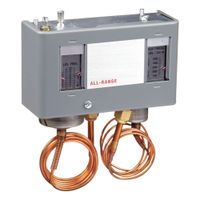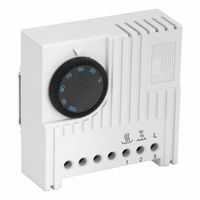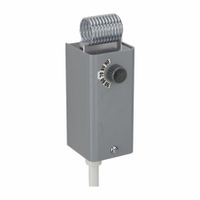Call +(254) 703 030 000 / 751 483 999 / 721 704 777
- Home
- Hvac And Refrigeration
- Hvac Controls And Thermostats
- Hvac Equipment Controls Components
.....Read More
Frequently Asked Questions
What are the main types of HVAC controls?
The main types of HVAC controls are:
1. **Thermostats**: These are the most common HVAC controls, used to regulate temperature. They can be programmable, allowing users to set different temperatures for different times of the day, or non-programmable, requiring manual adjustments.
2. **Sensors**: These devices detect changes in environmental conditions such as temperature, humidity, and occupancy. They provide data to the HVAC system to adjust operations accordingly. Common types include temperature sensors, humidity sensors, and occupancy sensors.
3. **Controllers**: These are the brains of the HVAC system, processing data from sensors and executing commands to maintain desired conditions. They can be simple, like a thermostat, or complex, like a building management system (BMS) that integrates multiple systems.
4. **Variable Air Volume (VAV) Systems**: These systems control the amount of air supplied to different zones in a building, adjusting airflow based on demand to maintain comfort and efficiency.
5. **Dampers and Actuators**: Dampers regulate airflow within the ductwork, while actuators control the position of dampers. They work together to direct air to specific areas as needed.
6. **Building Management Systems (BMS)**: These are advanced control systems that integrate HVAC with other building systems like lighting and security. They provide centralized control and monitoring, often with remote access capabilities.
7. **Smart HVAC Controls**: These include advanced technologies like IoT-enabled devices and AI-driven systems that optimize HVAC operations based on real-time data and predictive analytics.
8. **Zoning Systems**: These systems divide a building into different zones, each with its own thermostat, allowing for customized temperature control in different areas.
9. **Energy Management Systems (EMS)**: These systems focus on optimizing energy use, often integrating with renewable energy sources and providing detailed energy consumption data.
Each type of control plays a crucial role in ensuring efficient, comfortable, and cost-effective HVAC operation.
How do temperature controls work in an HVAC system?
Temperature controls in an HVAC system regulate the heating, ventilation, and air conditioning to maintain desired indoor climate conditions. These controls typically involve a thermostat, sensors, and a control unit.
1. **Thermostat**: The thermostat is the user interface for setting the desired temperature. It measures the current room temperature and compares it to the setpoint. If there's a discrepancy, it signals the HVAC system to adjust the temperature.
2. **Sensors**: Temperature sensors are placed in various locations to provide accurate readings of the indoor environment. These sensors detect changes in temperature and send data to the control unit.
3. **Control Unit**: The control unit processes information from the thermostat and sensors. It determines whether to activate heating, cooling, or ventilation components to achieve the set temperature.
4. **Heating and Cooling Components**: When heating is needed, the control unit may activate a furnace or heat pump. For cooling, it may start an air conditioner or chiller. These components work by adjusting the flow of refrigerant or air to change the temperature.
5. **Ventilation**: The system also controls air circulation to ensure even temperature distribution and maintain air quality. Fans and dampers are adjusted to regulate airflow.
6. **Feedback Loop**: The system continuously monitors the temperature and makes adjustments as needed. This feedback loop ensures the indoor environment remains at the desired setpoint.
7. **Advanced Features**: Modern systems may include programmable thermostats, zoning controls, and smart technology for remote management and energy efficiency.
Overall, temperature controls in an HVAC system work by continuously monitoring and adjusting the indoor climate to match user preferences, ensuring comfort and efficiency.
What is the role of humidity controls in HVAC systems?
Humidity controls in HVAC systems play a crucial role in maintaining indoor air quality and comfort. They regulate the moisture levels in the air, ensuring they remain within a desirable range, typically between 30% and 60% relative humidity. This is important for several reasons:
1. **Comfort**: Proper humidity levels prevent the air from feeling too dry or too damp, enhancing occupant comfort. High humidity can make temperatures feel warmer, while low humidity can make the air feel cooler.
2. **Health**: Controlling humidity helps reduce the growth of mold, bacteria, and dust mites, which thrive in high humidity environments. This is essential for preventing respiratory issues and allergies.
3. **Preservation**: Many materials, such as wood and paper, can be damaged by excessive moisture or dryness. Humidity control helps preserve furniture, flooring, and other materials by preventing warping, cracking, or mold growth.
4. **Energy Efficiency**: By maintaining optimal humidity levels, HVAC systems can operate more efficiently. Proper humidity reduces the need for excessive heating or cooling, as the perceived temperature is more comfortable.
5. **System Performance**: Humidity control can prevent condensation on HVAC components, reducing the risk of corrosion and extending the lifespan of the system.
6. **Static Electricity**: Low humidity levels can increase static electricity, which can be harmful to electronic equipment. Maintaining proper humidity reduces this risk.
Overall, humidity controls are integral to the effective operation of HVAC systems, ensuring a comfortable, healthy, and energy-efficient indoor environment.
How do HVAC relays and sequencers function?
HVAC relays and sequencers are crucial components in heating, ventilation, and air conditioning systems, ensuring efficient operation and control of electrical circuits.
Relays are electrically operated switches that control the flow of electricity in a circuit. They consist of an electromagnet, armature, spring, and contacts. When an electrical current passes through the coil, it generates a magnetic field that attracts the armature, closing the contacts and allowing current to flow through the circuit. This mechanism enables a low-power signal to control a high-power circuit, providing isolation and protection for sensitive components. In HVAC systems, relays are used to control components like compressors, fans, and blowers, ensuring they operate only when needed.
Sequencers, on the other hand, are specialized relays designed to control the timing and order of operations in HVAC systems, particularly in electric furnaces. They ensure that heating elements are energized in a specific sequence to prevent overloading the electrical system. A sequencer typically contains multiple bimetallic strips or thermal discs that respond to heat. When the thermostat calls for heat, the sequencer's coil heats up, causing the bimetallic strips to bend and close the contacts in a staggered manner. This sequential activation allows each heating element to turn on gradually, reducing the initial electrical load and preventing circuit breakers from tripping.
Both relays and sequencers are essential for the safe and efficient operation of HVAC systems. Relays provide control and protection, while sequencers manage the timing and order of operations, ensuring that the system functions smoothly and reliably.
What are the benefits of using advanced HVAC controls?
Advanced HVAC controls offer numerous benefits, enhancing both efficiency and comfort. Firstly, they improve energy efficiency by optimizing system performance, reducing energy consumption, and lowering utility bills. These controls can adjust heating, cooling, and ventilation based on real-time data, ensuring that energy is used only when necessary.
Secondly, they enhance comfort by maintaining consistent indoor temperatures and improving air quality. Advanced controls can monitor and adjust humidity levels, ensuring a comfortable environment. They also allow for zoning, which means different areas of a building can be heated or cooled independently, catering to specific needs and preferences.
Thirdly, advanced HVAC controls provide better system management and maintenance. They offer real-time monitoring and diagnostics, allowing for early detection of issues and reducing downtime. This proactive approach can extend the lifespan of HVAC equipment and reduce maintenance costs.
Additionally, these controls offer greater convenience and flexibility. Many systems can be controlled remotely via smartphones or computers, allowing users to adjust settings from anywhere. This is particularly beneficial for businesses and homeowners who want to manage their systems while away from the premises.
Furthermore, advanced HVAC controls contribute to sustainability efforts. By reducing energy consumption and optimizing system performance, they help lower carbon footprints and support environmental goals.
Finally, they can integrate with other smart building technologies, creating a cohesive and efficient building management system. This integration can lead to further energy savings and improved overall building performance.
In summary, advanced HVAC controls offer energy efficiency, enhanced comfort, improved system management, convenience, sustainability, and integration capabilities, making them a valuable investment for both residential and commercial properties.
How can HVAC controls improve energy efficiency?
HVAC controls enhance energy efficiency by optimizing the operation of heating, ventilation, and air conditioning systems. Advanced controls, such as programmable thermostats, allow for precise temperature settings based on occupancy patterns, reducing energy waste during unoccupied periods. Smart thermostats further improve efficiency by learning user preferences and adjusting settings automatically.
Zoning systems divide a building into distinct areas, each with its own temperature control, ensuring energy is not wasted heating or cooling unoccupied zones. Variable speed drives (VSDs) on fans and pumps adjust motor speeds to match demand, reducing energy consumption compared to systems running at constant speeds.
Demand-controlled ventilation (DCV) adjusts ventilation rates based on occupancy levels, ensuring adequate air quality while minimizing energy use. This is particularly effective in spaces with variable occupancy, such as conference rooms or auditoriums.
Building automation systems (BAS) integrate HVAC controls with other building systems, allowing for centralized monitoring and management. BAS can optimize energy use by coordinating HVAC operations with lighting and other systems, and by responding to real-time data such as weather conditions.
Energy management systems (EMS) provide detailed insights into energy consumption patterns, enabling facility managers to identify inefficiencies and implement corrective measures. Predictive maintenance, facilitated by IoT sensors, ensures HVAC systems operate at peak efficiency by addressing issues before they lead to energy waste.
Overall, HVAC controls contribute to energy efficiency by ensuring systems operate only when needed, at optimal settings, and in coordination with other building systems, leading to reduced energy consumption and lower operational costs.
What are common issues with HVAC controls and how can they be resolved?
Common issues with HVAC controls include:
1. **Sensor Malfunctions**: Sensors can become faulty or miscalibrated, leading to incorrect temperature or humidity readings. Resolution involves regular calibration and replacement of sensors as needed.
2. **Thermostat Issues**: Thermostats may be improperly programmed or malfunctioning, causing incorrect temperature settings. Reprogramming or replacing the thermostat can resolve this.
3. **Communication Failures**: Problems in communication between the control system and HVAC components can disrupt operations. Ensuring proper wiring and network connections, and updating software can help.
4. **Actuator Problems**: Actuators that control dampers and valves may fail, leading to poor airflow or temperature control. Regular maintenance and timely replacement of faulty actuators are necessary.
5. **Software Bugs**: Control software may have bugs or outdated versions that affect performance. Regular updates and patches can mitigate these issues.
6. **Improper Zoning**: Incorrect zoning can lead to uneven heating or cooling. Proper design and adjustment of zones can improve comfort and efficiency.
7. **Power Supply Issues**: Inconsistent power supply can cause control failures. Ensuring stable power and using surge protectors can prevent this.
8. **User Errors**: Incorrect settings by users can lead to inefficiencies. Providing user training and clear instructions can reduce errors.
9. **Integration Problems**: Difficulty in integrating with other building systems can cause inefficiencies. Using compatible systems and professional integration services can resolve this.
10. **Aging Equipment**: Older control systems may not function efficiently. Upgrading to modern, more efficient systems can improve performance.
Regular maintenance, timely upgrades, and professional inspections are key to resolving these issues and ensuring efficient HVAC control system operation.




